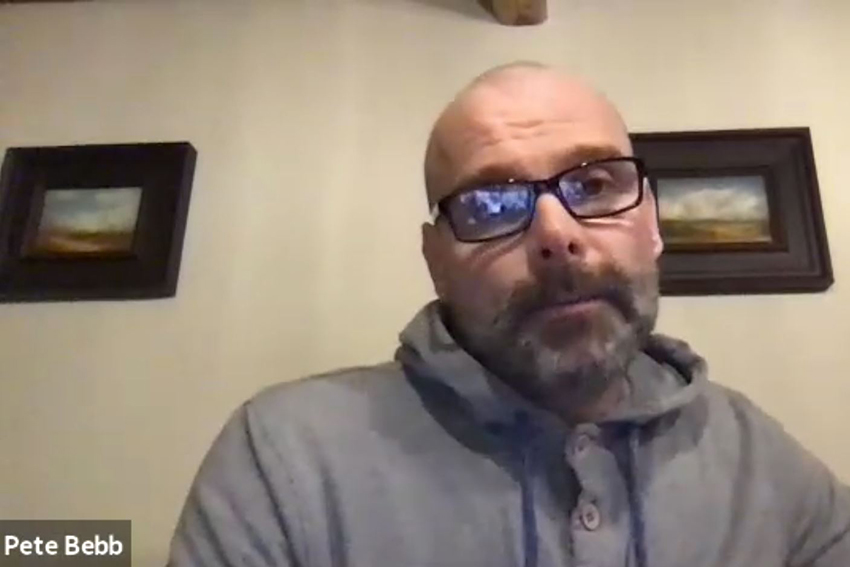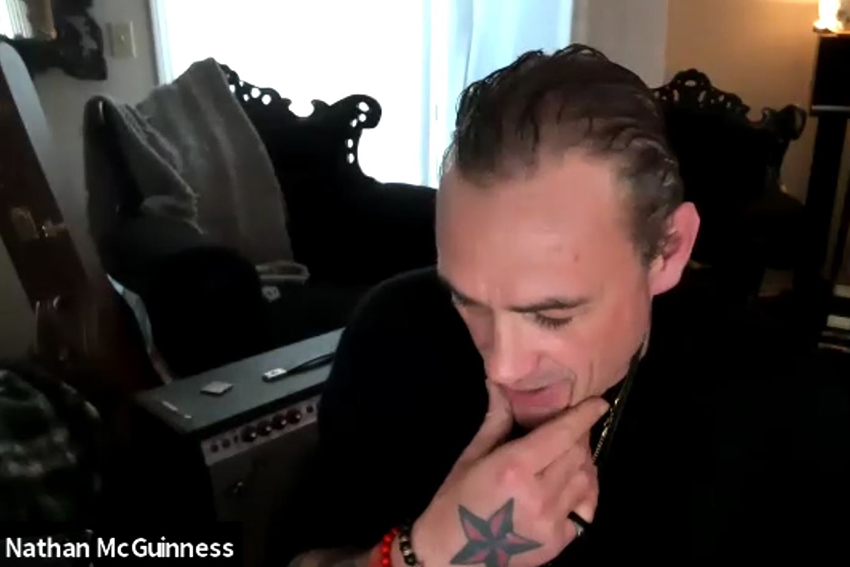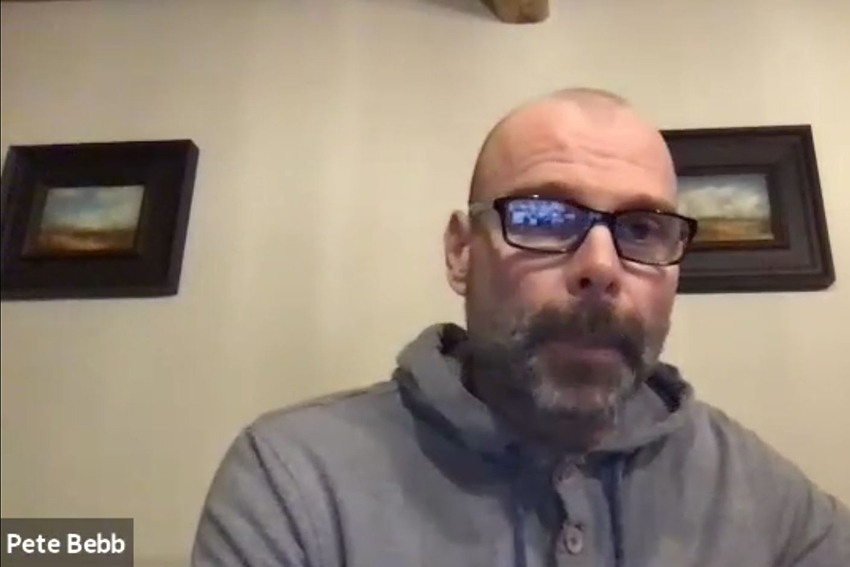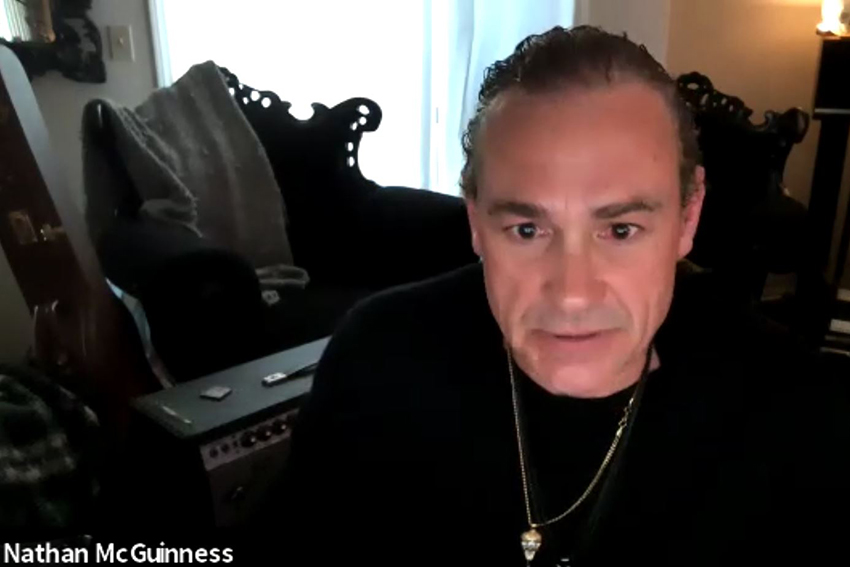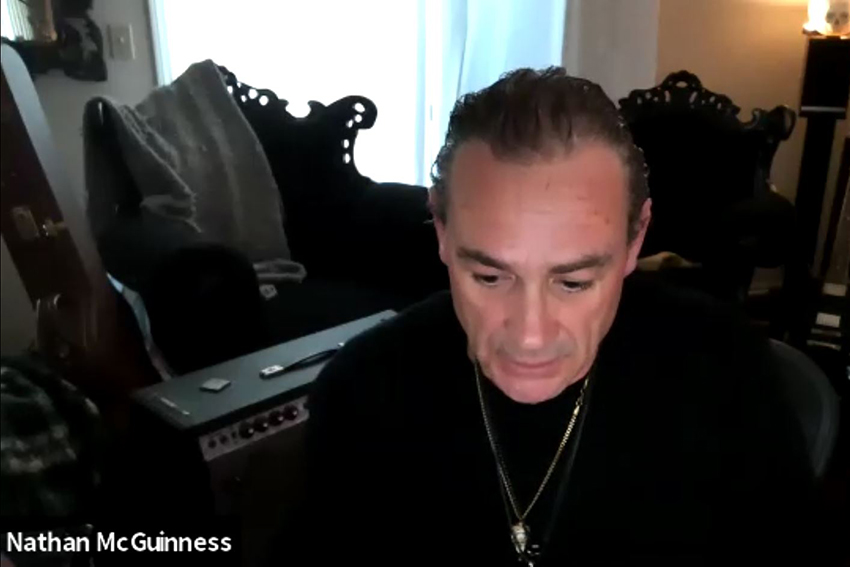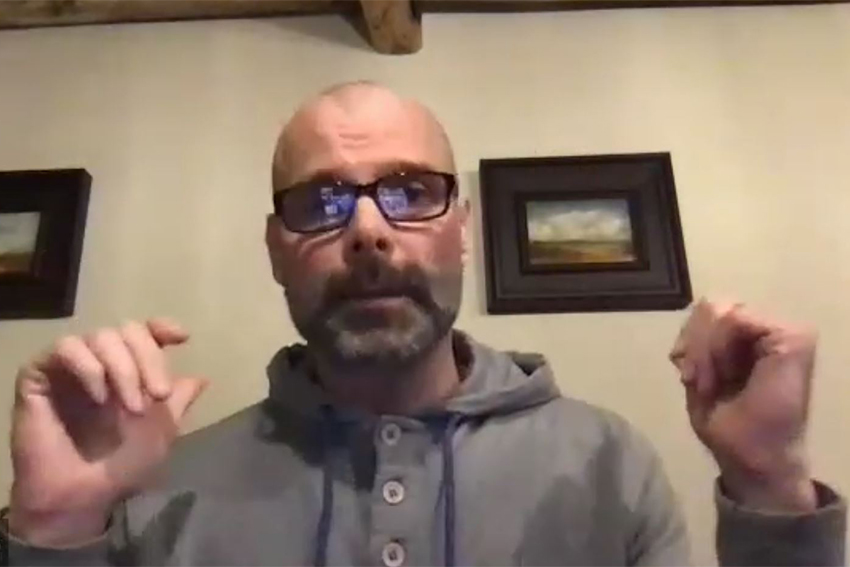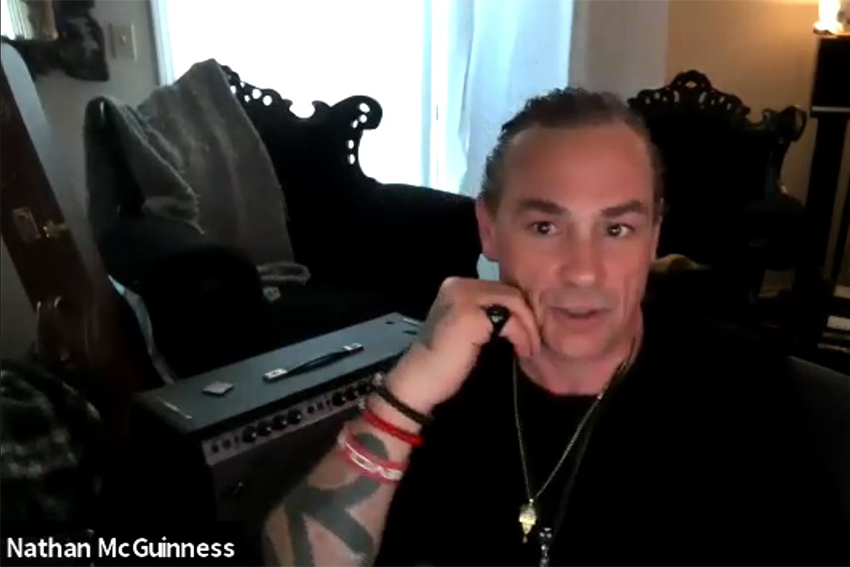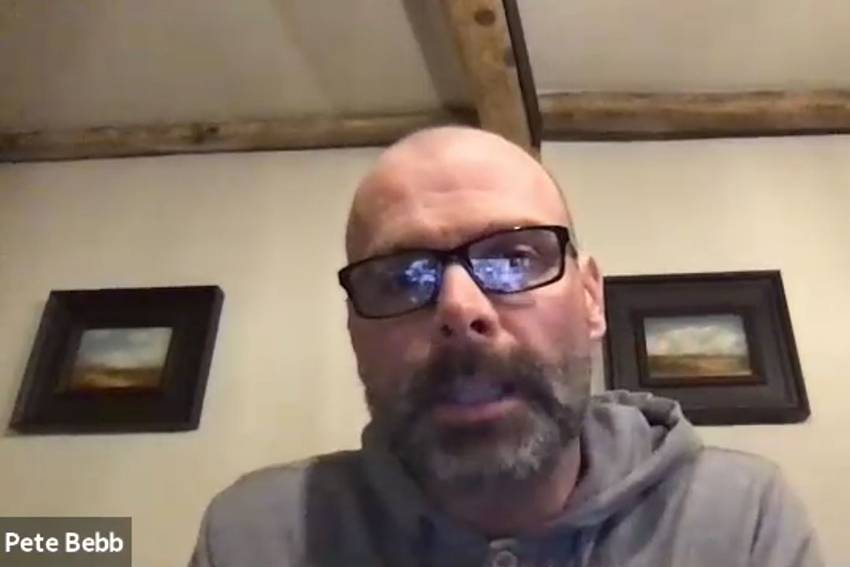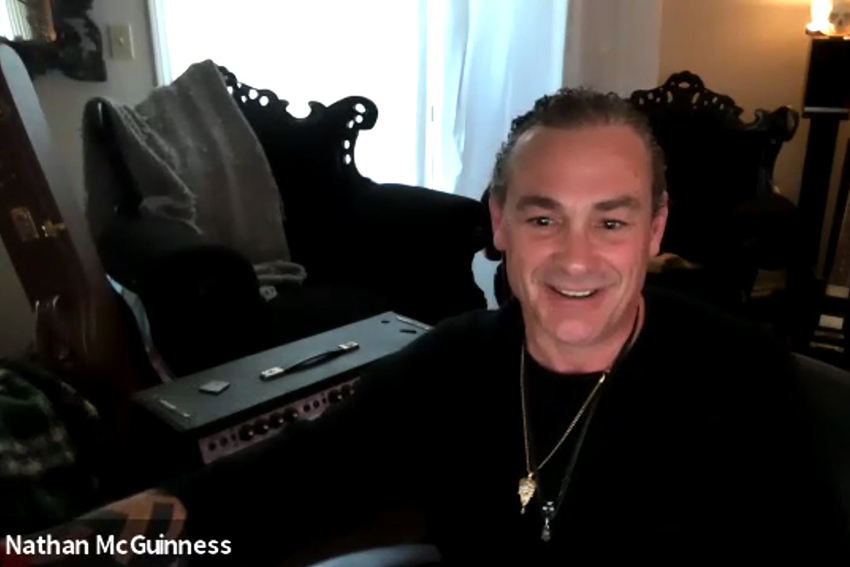AppleTV+ - GreyHound – Nathan McGuinness, Pete Bebb , virtual press conference
By Mulder, Zoom Event, 08 january 2021
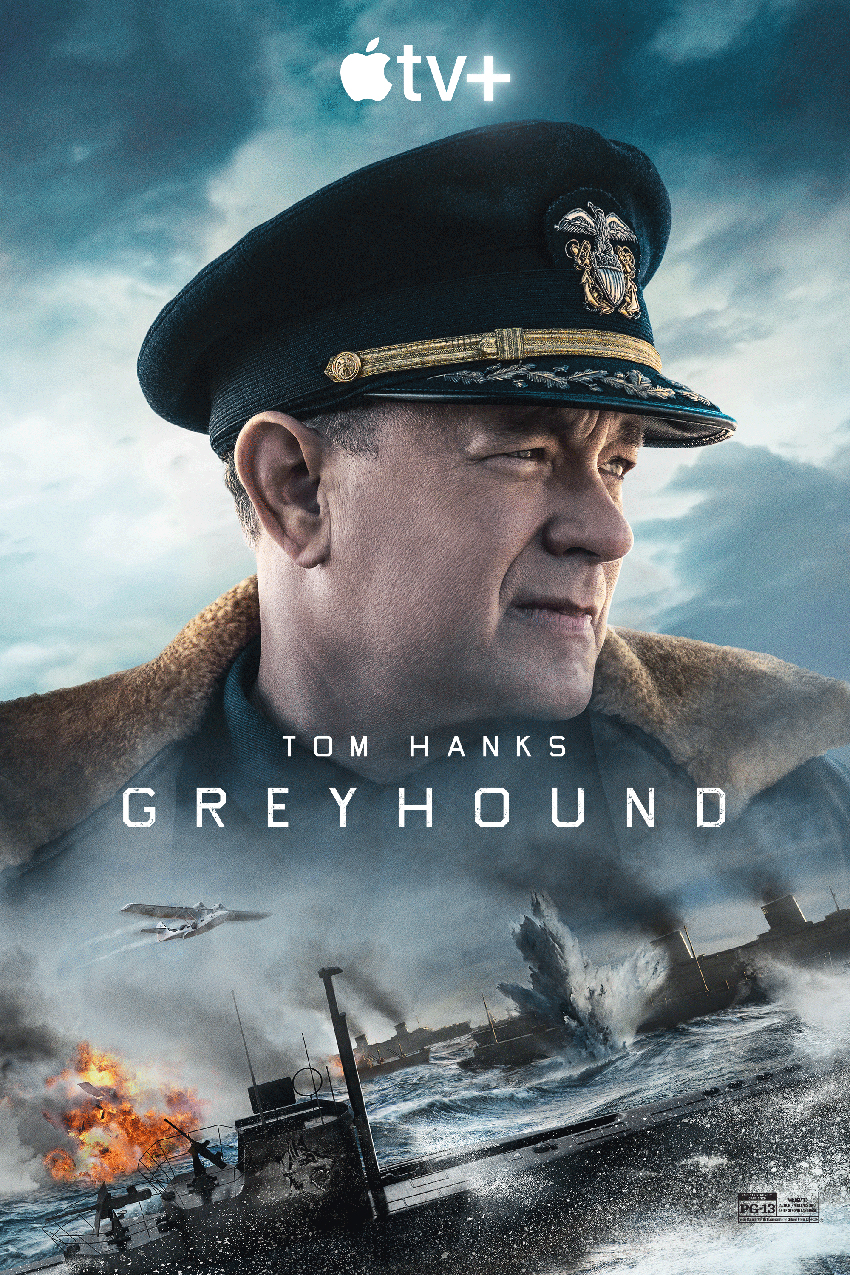
Greyhound is a 2020 American war film directed by Aaron Schneider and starring Tom Hanks, who also wrote the screenplay. The film is based on the 1955 novel The Good Shepherd by C. S. Forester, and also stars Stephen Graham, Rob Morgan, and Elisabeth Shue. The plot follows a commander of the US Navy on his first war-time assignment in command of a multi-national escort group defending a merchant ship convoy under attack by submarines in early-1942 during the Battle of the Atlantic, only months after the U.S. officially entered World War II. Greyhound was initially scheduled to be theatrically released in the United States on June 12, 2020 by Sony Pictures Releasing, but was eventually cancelled due to the COVID-19 pandemic after previously being delayed indefinitely. The distribution rights were then sold to Apple TV+, which released the film digitally on July 10, 2020. It received generally positive reviews from critics, with praise for the action sequences and effective use of the 90-minute runtime. Greyhound is a Playtone Production from Sony Pictures Entertainment/Stage 6 Films, in association with Bron Creative, Zhengfu Pictures, Sycamore Pictures and FilmNation Entertainment.
Today we were invited to a virtual press conference with members of Aaron Schneider's Greyhound team, available since July 10th on Apple TV+, to discuss with cinematographer Shelly Johnson, costume designer Julie Weiss, production designer David Crank, Composer Blake Neely, Sound Designer Michael Minkler, Editors Sidney Wolinsky & Mark Czyzewski and Visual Effects Supervisors Nathan McGuinness + Pete Bebb.
Q : hi so my question starting off is with the visual effects how did you find a balance between the look of the boats and their movements in terms of how do you mix the authenticity with the script elements to be dramatic ?
Nathan McGuinness : okay, there wasn't any ocean or gimbal so to speak in the whole project soyou know we did have obviously the set piece that you know which was mainly the wheelhouse we did have the kid in Baton Rouge but we didn't use it really in any way shape or form when it came to the environments the motion the ocean it really was a kind of a daunting project because we didn't have the ability to go out and shoot ocean plates we didn't have ability to have you know gimbals that helped us so we were kind of we were more going by the script going by what Tom felt, the environments and just the awful feeling of being in this situation not only a situation life and death but also the environment itself was you know pretty much all the way through the film pretty high seas and that was all generated in CG and pretty much anything you see outside cutting to exteriors were all cg and then what we did use was we extracted a lot of the actors off the kid and put that into to create the motion so it was a it was kind of like a lot of the dialogue told the story. Tom's what was going on in Tom's mind Versus what he was saying versus the script we were following a kind of let's just say a beat sheet to get us through the couple of days of the story with the environments with the knights with the attacks with the with the U-boats with the tactics with everything was built around the dialogue in you know inside Greyhound. So we didn't have anything to reference from the show so to speak besides a couple of big gimbal shots that we did use but mostly we went to town and built a fleet and this was not this was not normal for Pete and I. I came in looked at the cut realized that the dialogue worked it was very it was very technical in a you know in a naval sense but for the viewer we they really we needed to really fill the holes with what was going on around the story. So we had to really get to work and we got to work fast by research on that era period, ships obviously, i built a library for Pete kept it very slim and narrow on exactly what we needed to achieve meaning besides the swell the look you know the both the vote for scale which is obviously you know the wind and size of ocean which was pretty much you know high seas all the way aside from the funeral now that was a classic case of the only time we really used exteriors of the ship in baton rouge and as you can see we had to calm the ocean down to minimal because the ship had no it wasn't on the gimbal no one's moving so we had to kind of alter our style of high seas for that moment which worked anyway for the funeral but we immediately started really previously and also really using the dialogue of what we would be doing if we were shooting boat to boat what would the circumstances be like what would the equipment be that we would be using how would be using it how you know all of this was coming this was all dialogue for Pete and i. Pete to convey to his selected team that he that he kind of hand-picked for the job we only really had four to five months from the get-go the only head start i had was research and that means everything to do with this movie we found at that period. You know from the guns to damage to explosions too everything was always backed with some realistic visuals of you know even to the point of torpedoes how they sounded how the five inch Gun sounded, how you know the subs the it all evolved over time uh at a really fast pace and we kind of felt that we were you know we started off with a couple of references of some pretty severe ocean. Pete and i actually felt like we were getting somewhere and that really kind of put the energy and steam into to dean egg Pete and his team because we were actually getting something that we were really liking that's a very long-winded sorry answer but I’m trying to frame it for you in the way of the understanding of there was really nothing to work with as besides from a great script and a great actor and great interior work and we you know had to go down the route of time stamping the whole show from the beginning to the end and Pete had had the system he did time-lapse hdris we were able to use them as our time stamps on all the periods so the lighting was kind of following the movie we had you know it was i let Pete speak very military driven movie to get it done and this is i'm saying peace words now so that's kind of a little bit of an answer for you.
Pete Bebb : i think from my perspective when we were first approached by the client Gareth regards to this show time frame was obviously something to consider but equally obviously it being a Tom Hanks war film you can say no and that's obviously you want to stay authentic and you want to be sure that the quality is guaranteed throughout the entire films and we were very conscious about authenticity as were Mike and Tom and the director and of course Nathan they did build a huge database of stuff for us and it was a lot of stuff which was not previous films of course but all genuine stuff, the stuff greyscale stuff you know the really old good old images of north Atlantic you know ships, you know the escorts and the convoy and there is quite horrific stuff. It's quite horrific there and really tried to drive the look of the film it was basically weather for me so that was a kind of the ocean obviously it's derived by the lighting and the ocean as Nathan. They've said in previous interviews the ocean was another character so that had to be determined and that was not determined when we came on of course uh there were a multitude of different assets to do and as from a normal perspective you'd have to do all that but because of the time frame we were doing all this in parallel so we had to get the ocean up and going as best we could now what was fantastic was the Nathan obviously she said I just say the filmmakers put together a beach sheet right they blocked out all the film put what the scenes were in there and what they wanted from your narrative perspective character what they wanted those scenes to feel like right now if it's just a ship on an ocean then the weather lighting albeit very minimal and it being winter north Atlantic it's a very barren and inhospitable place now thankfully weirdly enough being in the UK where there is bloody appalling and it was winter when we started this show you know contact is in October November time I immediately basically sent out crew to the four corners of the UK to shoot on the coastal regions okay so we needed that clean horizon line critical you can't do it off the top of the building in cities because of the light spill and this then would light the ships and it would be entirely artificial so we got a whole multitude of time-lapse HDR essentially we have a thing at the end called sky capture which is essentially 10 HDR cameras set up on tripods and they do time lapse you can set the time and we just sat there for 12 hours and just did it from you know dawn till dusk because essentially that's what you are doing in the one-to-one time frame with Tom in Greyhound you're following that beat by time of following this captain through this huge ordeal that he has is his first kind of outing as an escort so from that i looked at all the scenes Nathan the team gave us what the oceans what feel they wanted for it and obviously Tom's big into this of course about how it should be you know whether it's incredibly cold what the Beaufort should be how in hospital it should be along with hero bits of reference now the database of reference was huge but really when you deal with the crew and you say look i've given you a thousand clips of a bow fort nine to ten here pick one it doesn't really help so Nathan picked one specific right and i'd say there's one hero clip that judged 90% of what the ocean was going to look like and we just matched to that started from scratch on that before we did any shots we were like that's the ocean that's what it's going to look like that's got the feel right it's weird when you do a show that one specific thing could actually actually really be so keystone to look at the film that of course with a few hero shots from some of the pathetic stuff of the real world war ii stuff you know and we then basically put HDR i did suggestions of what the time of weather and ocean look and the sky HDR to each of those scenes okay then Nathan just picked those and then from that then we then worked up the ocean and worked up key shots throughout each of those scenes and then what i did was categorize shots within the film that were all typically the same so there's not going to be a multitude of different shots every time because it's basically a ship and a camera right so there's going to be shots of you know a POV or should say a slightly cheated POV of Tom's look from the bridge looking at the bow of the ship go into the ocean it's a very typical shot you see within some of the very historical archive footage there's probably about 40 or 50 of those shots so we knew that if i push one of those very quickly to the final and that would develop a look which would give them quite a few shots and if i had a multitude of those through different scenes in the film different lighting conditions night calm stormy icy then that would give you an idea about what each of those scenes would be so then i've got a hero shot in each sequence which can show the filmmakers exactly what that sequence would look like at that time and then i could bring all the other shots up to a similar level all right so from a narrative perspective again sorry along with an answer but the narrative thing was given by the look and feel and the weather of the ocean and the ship and how it reacts in there and that's what gave the entire field from an earth perspective for the filmmakers so that was that's basically where we started it was essentially weather
Nathan McGuinness : see we're both long-winded answerers. We are, you know, you don't need to ask any questions
Pete Bebb : yeah i mean it is for a full CG ocean and i mean look we all wanted to go and shoot this obviously Nathan and i joined the show quite late so of course we go and shoot plates we're both huge believers and i'm like Christopher Nolan and all the rest of it i get as much camera as i can i love that and masculine commander from Nathan of course is obviously in place and gills all the rest of it unfortunately wasn't time for that CG gives you that latitude and flexibility to create what you need to create and then from plates that were shot very early on and from reference material then you can all you can do is match like for like for that and i mean that from designing the cameras to be a boat to boat feel nothing in there is any of this magic camera stuff that you have you know that was not the intention it was meant to feel like you were there in amongst it and that's what was critical to the actual feeling of the film all right. i think that's what's key to a lot of what you see on there because it gives that genuine sense of authenticity because you can create photo realism right for this that's okay but with a camera it can take you out of that very quickly on shots like this where the actual media you've got in frame is an ocean and a ship and a sky and the weather basically so that's why cameras so critical a lot of stuff that we've done as well.
Nathan McGuinness : i think also because time was not our friend and we had this little time it's a you know it's something that hasn't really been said but you know Pete and i didn't actually final verbally to each other because we still felt that we could do so much more. We just didn't have the time and you know the result was great but we know that if it was a normal film with a normal time frame we still had a lot of other layers we were like you know we both you know i pushed and pushed for like you know it was you know reality versus you know insanity versus you know you know knowing that we're on the, we were grasping something that we i was dubious about originally you know for full cg and you know we were we were onto something another and another thing is we had a bird's eye view roadmap of the whole show so editorially i was always able to go to my VFX editor and see where we are which direction we're going and obviously there's a whole other story to be told about then the engagement of U-boats tactics the way the convoys move through the north Atlantic all of this was carefully mapped out so we didn't get lost because like Pete said it's there's nothing out there but you know horizon and the only way to know where you're going it was you know obviously you know for us visually the sun you know and we were constantly having to check ourselves because you know the convoys were constantly you know zigzagging and using tactics to avoid any kind of you know the shooting duck situation that they were in with the with the wolf packs I’ll stop talking for a seconde.
Q : hi guys thank you both for joining us today and providing so much incredible insight already so one of my favorite parts about watching a film on streaming is you can watch it over and over again especially after speaking to you i want to watch it again and so what do you suggest audiences there's questions for both of you by the way what element do you suggest audiences look for the second or third time they watch it to really gain a deeper appreciation of the film and something they may have missed because they didn't see it in theaters.
Nathan McGuinness : i think that it was it was designed to be on the big screen you know and so which you know obviously today you know we're in a whole different world and you know i think it's brilliant that Apple picked it up and it was able to be seen and the scale of what and the impact on the big screen was amazing. I mean Pete was seeing it. You know in London i was seeing it you know with at company three and it was huge what i think people would look at and this has come from a few a few of the even the older folks who have seen the show is to explain to them that it wasn't real you know i mean the there was no opening sequence with a plane you know saying you know tally ho and off you go you know i you have to explain you know like to my father i had to explain to him no that was actually there we built this and the takeaway for audiences i think would be hopefully that that you can get through the film and not cringe and think that it is you know completely CG. I hope that people think that maybe it was a combination you know i hope that we i hope that that we got people guessing on the techniques on how we went about making this film because we were painted into a corner and we had one choice and that was to do it the way we did it and Pete and i are very in camera technique guys but we both have a technical background but we both have an organic touch but we had to go very technical but at the same time we kept it very practical and organic in the way we did our dialogue together and i hope that if people were to see this and know a little bit more about what we're doing and what we did that the world was created from in the in a full CG environment following all of the cues from Tom really and you know that's something that i don't think we've been able to actually say yet to anyone.
Pete Bebb : i think it's actually a really interesting question actually Andre and i think that any i should say certainly for any Tom Hanks war film or any good war film if you've watched the first time you watch it if you're inspired then go and look into it right particular battles or for example bander brothers with 101st like I’ve done similar things not i've been in world war i but I am certain ageless i enjoy that stuff and i think now is quite critical i think lights down obviously it's a shame that's not on the big screen because the actual gamete of color that you have in the north Atlantic in the middle of winter with grey ships on a gradation with a grey sky obviously the subtleties there i was always worried from a technical point of view that some of that may have been lost with people's fancy plasmas or whatever you know because there it has to be the grading there is very subtle and I think that if you watch the film if someone wants to watch it again then i would say just go and briefly look up the battle of the north Atlantic and you will see what was actually undertaken by the crewmen and just what was achieved under such i mean it's generally a Turkish shoe they couldn't see their adversary you know it was there and they were just getting shot out of the water the front center and left for dead and i think that's and they are out of range of course which you get from the film you know the Catalinas the circles they draw and that middle bit is just a ghost town essentially and I think that's what i get from it and when i watched it for the second time i did go and i didn't really know a huge amount about the battle in north Atlantic that must be fair there's certain things that Nathan and the actual naval adviser that Nathan's team had Gordon told us about stuff and about certain scenarios in the film which you'd think would be unbelievable like submarines are actually servicing right next to escort ships which you think you know why would they do that's insane but they knew that they couldn't depress those grants down close enough and they knew the closer they got the more effective they'd be at taking that thing out and i thought well you know but until you read it you actually know about it then you don't know and i think that's what's quite interesting because what you have to understand of these films you're not making up sequences here they're very authentic to what actually happened and i think that's what's key it's also what's critical to what makes the film feel real you know
Nathan McGuinness : it's not in streams but we went to the level of listening to journalists on you know the merchant ships while attacks are occurring and they're recording their dialogue so they're amazing accounts of the descriptions from that moment in time we had this we're listening to this so it helped us try to understand and to try to be a part of the film on the visual standpoint and also to put ourselves in that situation as well as a filmmaking situation as well as a character situation.
Q : hello what should be for you a great collaboration between a visual effect supervisor and a director and my second question what can you tell us about your collaboration with Aaron Schneider ?
Nathan McGuinness : first question was visual effects supervising communication in this situation was more of a collaborative conversation because it was Aaron Schneider from filmnation and Tom Hanks and Gary Goetzman from Playtone. we came in and you know i sat in a dark room with Tom for hours as he tried to describe to me how he felt when he developed the screenplay and when how he felt how awful and this and how gut-wrenching it must have been for the merchant the merchantmen and for the naval and also for the u-boat he that was more valuable than anything is to have that communication just look you in the eye and tell you that so heartfelt so that and with Aaron Schneider who was very persistent in reality you know there is no tricks there is no whizbang this is it's all it's all based on a real situation which is you know very strongly pushed forward by Tom and at the time that Pete and i were on it was really the communication with Tom and Gary and Aaron and it was really a very small team it was you know Pete and i really were just engaging with each other every day i was pretty previously like mad with the small team and that was kind of the organic situation of what was going on and Sydney our editors and our VFX team were we were putting sequences together we were presenting them to the directors and the filmmakers and you know we i personally was housed at Playtone which is Tom and Gary's offers so it was a daily thing where i could easily if I needed to get any feedback the feedback was instant you know it was basically you know just walk through the door so that was a very interesting way of working and it was very beneficial for us that was the first question could you just repeat the second question for me.
Q : my second question in only one word what can you tell us about your collaboration with Aaron Schneider
Nathan McGuinness : okay the collaboration with Aaron Schneider was you know he's a director he's a DP he was very thoughtful about the difficulties of what we were in. He wanted the authentic feel. He wanted to give Tom the authentic feel that that i know that i got because Tom and Gary and the guys were really persistent about it and he was the great thing about it was he because he understood visual effects he understood the difficulty so he didn't put the pressure on us he didn't micromanage or see you know we had to get the job done and he felt that the credentials i think that Pete had and myself i think that he felt that he was and this is a good thing he felt like he was in good hands and i felt like i was in good hands i felt like Dean and Pete we didn't i didn't go for multiple vendors it was we had to go for trust and we had to we would you know trust me what this was all about and sometimes you've got to throw everything away and just go with your gut and the gut was you know Pete and the team um and Aaron was so excited when he found out the you know you know these the caliber of people working on the show so that was the greatness and you know it was always good feedback it was always positive it was that's the joyful part about it was we were eft to our experience as visual effects specialists to do our job and that was what you know you know very well that on every film we have to all of a sudden become experts per se at things that we you know not experts at so you know we lent on you know advisers advisors that i've used all the way back from like Master and Commander we had to lean on each other for or just keeping up with the movie and not dropping the ball in areas because we had so much to carry but i think the keeping the group small even though it was a massive team working on the show but keeping us and having the freedom to do our job is what the director did that's what Tom Hanks did that's what Gary did that's what Aaron did and i think that's what made it really special for Pete and i because we really felt like we owned.
Pete Bebb : from my perspective i didn't have a huge amount of interaction with the directors or only with Nathan on a regular basis. The biggest thing for any team that i do when i do a show is to certainly something like this where you're dealing with this particular subject matter is to try to one we hand-picked the crew for this and because of the turnaround and what we needed to do logistically right and then the other thing was is was to be sure that there was a certain level of enthusiasm for this show right and that wasn't hard to gain at all in fact the first thing that we did was we got the crew and then we took him down to the HMS Belfast down at London bridge right which is a world war II destroyer and that was to give them some idea about just what one of these ships actually looks like close up because we didn't know from the shots that we were doing they've not been designed yet right how close we were going to get you know were there grazing shots we're going to be seeing weld how did they do the world was it kind of messy was it kind of rushed what was the paint like what did they do and the good thing about that wiggling up is people got really into it and the crew were interacting with people that actually served on HMS Belfast in the war right so that already got their attention and all of a sudden that asset that we were building you know greyhound obviously all the way through benefited from that the shop design benefited from it and it also allowed a crew of you know a thousand plus knots i took them all down obviously the scenic crew went to get them onto the same page we thought Nathan was doing and what Tom had spent all that time years developing the script it's a great way of getting everyone on the same bar to do a show like this because typically visual effects films can be random scatter of all sorts of stuff right this one we were so conscientious about the fact that authenticity is critical and that was what we actually brought to it to be sure that we were being respectful to the subject matter right.
Q : Gentlemen, great to talk to you. does not you have the water but you also have torpedoes going through the water and you also have explosions on the ship i mean it's bad enough to design the water but then to have all that going on talking about that process that to me is is really amazing.
Nathan McGuinness : well that process was i decided to just bring in a very small crack team of pre-utilization guys and girls who really understand i knew them and they understood myself broke down the engagements and you know kind of tried to build sequences that made sense usually. You know to per the script and then we had to really work in a bird's-eye viewer at first when it came to where the torpedoes were coming from where which ships were getting here the speed of the torpedoes the speed of the ships the direction of the ships the everything was very confusing if you didn't look from above you know and if you didn't look from above you would be lost so that was really the stage one was dissecting the sequence or what i'd always call just the beats you know two to each sequence that had a big accent which had a big interaction between maybe a hit on the torpedoes or a near miss or anything like this it was all based on developing that from the story, from the script looking at it previously doing everything from above first then bringing the cameras down then seeing where angles would work and help tell the story then obviously in the background we had reference footage of you know damage to ships, explosions on ships. We had you know obviously effect teams working on that we had reference footage of torpedoes you know moving through the water we had all we had so much in the background going on well we're well with you know to get the impact though and the different types of explosions because it depended on the ship it depended on what was it carrying would depend it depended on the side it depended on where it was all of this stuff was being put into consideration through teams. The making sense of the story was very difficult because of the where you put the camera you know from the point of view how much do you see where is he where he's so it's a conversation that i we could really honestly talk about for hours but in a nutshell it's you know we always started with looking at everything from above so we could see where we were nautically and what where was to start where were the ships where the torpedoes come from what u-bike was it coming from how many because obviously you know it was it was even if there were you know the merchant ships and other ships and U-boats not even in the scene i we knew where they were and that you had to know that if you didn't know that it would have been an absolute debacle you know it would have been you know who's on first it would have been ridiculous so we had we had to have that road map of an understanding of the real world and that real world then enabled us to get our cameras place our cameras do what we needed to do see what's missing see what was reading how long and the effects instead the driver the look started to drive it the you know we that's a quick answer.
Pete Bebb : it's quite true actually i think what's nice about this show actually is the fact that typically on other shows i would say there's always a little bit of compositional cheating right to find that shot and I what i love about this is that we were so brutally truthful and honest because it would be again you're taking out it being authentic if you're cheating stuff so if a particular escort couldn't get there in time because it was a Canadian class and it wasn't as fast as some of the greyhound ships and could only do x amount of time and it was carrying this load and we calculated lows we calculated displacement we calculated all of that so if it couldn't get to a particular area to help someone out well that's how it was going to be right if there was another sub that was here that we knew there was firing a torpedo and again the one thing you should know i mean we i guess there's one thing i didn't realize is of course they fire to where the ship is going to go so there's a scene in the film where it just goes right past you know and then they obviously they track it back you know they do a reverse whatever it's azimuth and there's all that stuff i find really fascinating so when you see all this mayhem going on and the chaos that is how it was that was the fog of war these 20 mills the bow fours the explosions of the torpedoes all of that stuff i find fascinating and that what gives that real again when we looked at the authentic footage there is that and it's that sort of some of those scenes that as you know Saving Private Ryan for the beach scene you know it's that sort of stuff that brings it who was there the people who actually there have a real kind of feeling that's actually a little bit too raw and i think that's the kind of thing that we felt that we really needed to achieve so you know there's a particular scene i'm jumping off the gun here slightly at the nighttime sequences where i remember i showed my particular scene where a ship the greyhound nearly grazed one of the huge tankers i think it was one of the passenger ships and you know what how the hell that could happen that thing's like massive and it did happen because they couldn't see anything you could see barely a few meters in front of you because everything was a complete lockdown I mean Nathan was telling me an interesting story if you're a naval guy you get you get reprimanded or was it sent to the brig whatever you had a cigarette on the on right because you can see that light a mile away or whatever you know so stuff like that errors like that cost lives and i think that's what's nice about this so shots respected that scenes respected that and that again is very much directly related to what Tom wrote and that's what we wanted to be very sure that we were doing and that road map that Nato's referring to is all designed by radar maps done by Gordon and everyone else about what would happen in a particular scenario if you was spotted here who would go what would happen to the convoy so we basically took all those road maps and there was scores of them into one giant master scene from our perspective one giant layout master scene you could basically scrub through like a little mini battleship so we knew what you would see at a particular any point in time in the film what Tom would see when he was looking off the starboard or the poor bow or whatever you know at whatever time i think that's critical to a type of film like this
Q : this is a very general question but I’m so fascinated by the evolution of visual effects and the advancements in the technology of the industry so i wanted to ask what are you excited to see more of in the future of the effects and entertainment and what do you hope to do more of or experiment with in future projects ?
Nathan McGuinness : it's funny because you're the only one who's ever asked that question and I’m the only one who's ever actually answered that question without the question been answered you know the takeaway from Greyhound was i feel that i feel like movies made around ocean is always a run for the hills kind of situation in a lot of cases. You know i feel like we went into a world of i think we took it to another place or i feel like there's some a world or a future in more gritty films. You know on the historical because god knows there's that many on you know land on the war um i think that we've opened up an avenue where we can have complete control we can and we can do better we know we can and not saying we did bad i'm just saying we this was very calculated in the way that what we wanted to get done but i think that we were fascinated on where it could go as you know senior guys who have been there been there for quite a while for the 25 years. You know probably, half a bloody century but i feel that it's opened up the world of quality i think we could almost create believability now and that to me is the exciting part because you know you wouldn't want you know you'd want to do another mastering commander now you know you want to do a secret you feel like you could almost relax a studio by saying look this is the tip of the iceberg you know we with more time we can keep developing and I feel like it's not just the technology I think that's a big part of it is a big part of it but it's also the right people right team and right mentality you know using the it's still. It was still a lot of manpower like Pete said nearly a thousand stuff so it's a big wheel to turn but i feel like there is a future that can bring up it can bring writers and storytellers more for the first but for me for the first time that i feel great i mean.
Pete Bebb : for me, i think that from the first you know technology is a huge thing with this film surely purely because the amount of effects so there's a huge amount of number crunching going on and what is beautiful now which is just you know the game industry and unreal engine all the rest of it utilizing that so you can bring a finished visual and design that with the director and the filmmakers so they feel like they're there shooting that thing for real is the thing i think which is exciting because there's always going to be a little bit of turnaround time and leeway for this stuff based off basically hard render power and calculating and i think that that sort of thing the closer you can get to making it feel like you're going to go down onto a set or go on to a location and shoot this thing and everyone's there you know that's what really helped because it gets everyone into the actual mindset and I’m including actors on that and getting them into the field so they're just not you know typically visual effects is green screen holding a green cushion for a tiger you know and getting people on board with that is always a bit tricky so i think that technology for me is definitely a thing that will help bring a film like this to the forefront of making it feel a little bit more real and authentic getting everyone
Nathan McGuinness : i think our technology is so far ahead now that we have time to be artists but right you know we have time to talk and do dialogue like filmmakers, like cinematographers, like a camera crew, you know like i came up you know we can talk that way and we've got time to execute that way because technology is better and faster and we've got time to be more filming in in the way we talk to each other you know and i'm talking about us Pete and i mean help albert's the guy you know talking about their numbers and but that there's all these avenues now and skill sets that are really now come together to allow us to be more filmmakers.
Q : speaking of the innovations that you judiciously and successfully implemented and executed in this film wherein you literally moved heaven earth and the vastness of the ocean of the sea of the water in the most magically possible ways my question is what effect do you think will this have on the overall weather and tide of filmmaking especially in the context of the covid pandemic that we are into
Nathan McGuinness : yeah sorry i'll keep it real quick I think we've opened up some avenues to be able to you know do as we've done we you know you could basically shoot Tom you know on a set and we can build a movie around it hat i think that's i feel like we've opened up the doors to being able to present quality filmmaking around a situation like this please people would be able to answer this one better to be honest.
Pete Bebb : i mean for me, i've just finished another film literally it was a pandemic show and i think that what you tend to do with these things is you try to overcome as best you can and still maintain the quality of the product and i think that's weirdly enough from a from our side of use filmmakers official effects point of view is opened up a lot of different avenues and a lot of kind of more structured and lateral thinking to how you solve an issue and solve problems so big cg film like this plates ocean you can blend all that together and try to do it in the best possible way but still retain some of that authenticity that you get about being on a film crew on a set and i think from a technical point of view and the advances of technology that's always going to go you know that's always going to get better and better and there'll be a more finished image because i was only discussing the day about previews and back in my day used to be stick figures in two colors now it's almost like a finished film and i think that's what people expect it's whatever you can get to the closest final product in order to try to sell that idea and sell that concept.
Nathan McGuinness : and i think sorry one thing but what's very important is that the understanding of sets you know so you know we can create a world without a camera crew but we can't if we don't understand how a camera crew works how a camera works how a piece of equipment works you will not get the authenticity of a film without the experience of working with rigs that break the imperfections all of this comes with the filmmaking on set experience otherwise you don't you don't understand what it's like you don't understand but you've got to put yourself on the piece of equipment you think you're going to be using and the camera operators abilities and if you haven't done that and stood with guys and been on the wheels you know or been on uh you know an arm or been on a handheld and done this it's very hard to generate the realism of filmmaking you know that's where you're taking visual effects is one thing but the understanding of field making is absolutely crucial.
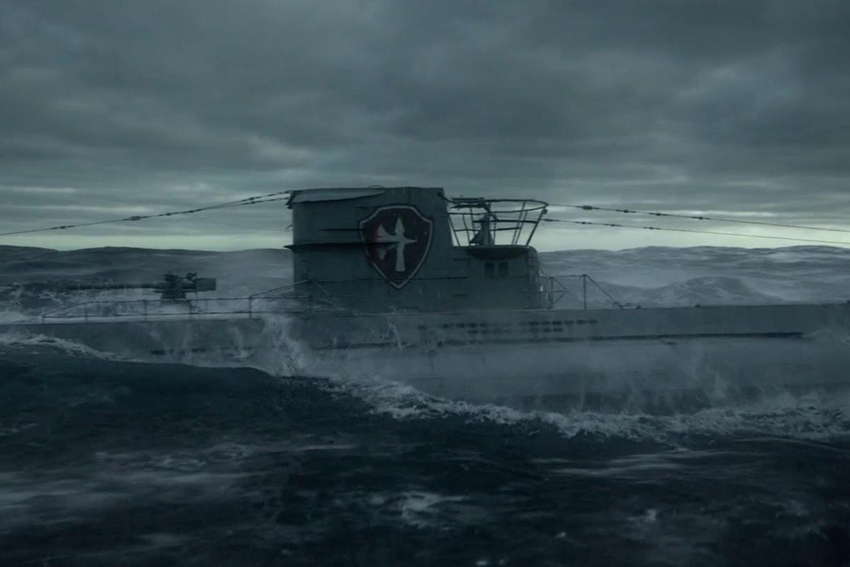
Synopsis :
A longtime Navy veteran who, as a first-time captain, is tasked with protecting a convoy of 37 ships carrying thousands of soldiers and much-needed supplies across the treacherous waters of the Atlantic during World War II. For five days with no air cover, the captain and his small force of three escort ships must make their way through an area of the ocean known as “the Black Pit,” battling Nazi U-boats while protecting their invaluable ships and soldiers. “Greyhound" is inspired by events during the Battle of the Atlantic, which took place in the earliest months of America’s alliance with Great Britain and the Allied Forces.
Greyhound
Directed by Aaron Schneider
Produced by Gary Goetzman
Screenplay by Tom Hanks
Based on The Good Shepherd by C. S. Forester
Starring Tom Hanks, Stephen Graham, Rob Morgan, Elisabeth Shue
Music by Blake Neely
Sound Designer : Michael Minkler
costume designer: Julie Weiss
Production designer : David crank
Cinematography : Shelly Johnson
Visual Effects Supervisors : Nathan McGuinness + Pete Bebb
Edited by Mark Czyzewski, Sidney Wolinsky
Production company : Sony Pictures Entertainment, Stage 6 Films, Bron Creative, Zhengfu Pictures, Sycamore Pictures, FilmNation Entertainment, Playtone
Distributed by Apple TV+
Release date : July 10, 2020 (United States)
Running time : 91 minutes
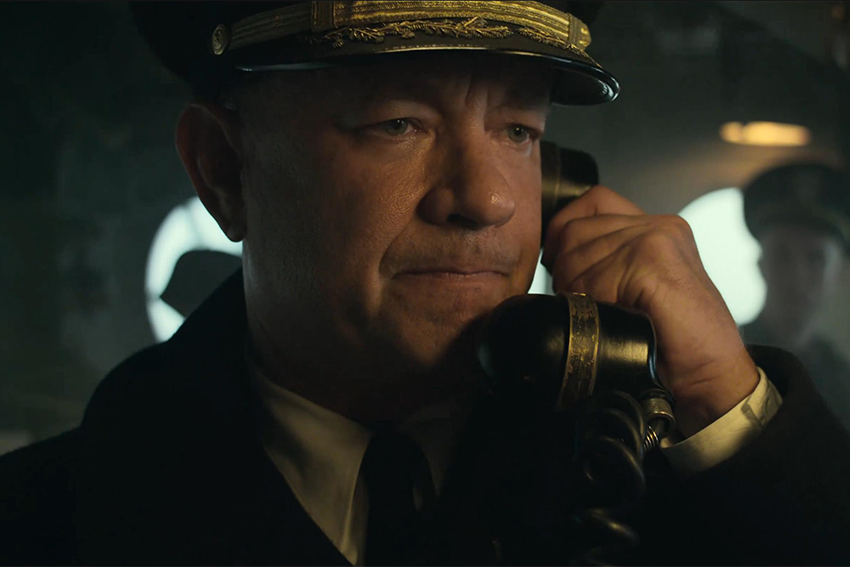
We would like to thanks Ivy Martinez for invite us to this virtual press conference and the different talents for answered to our questions.


